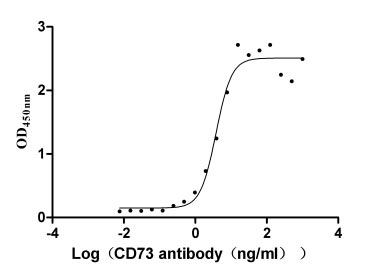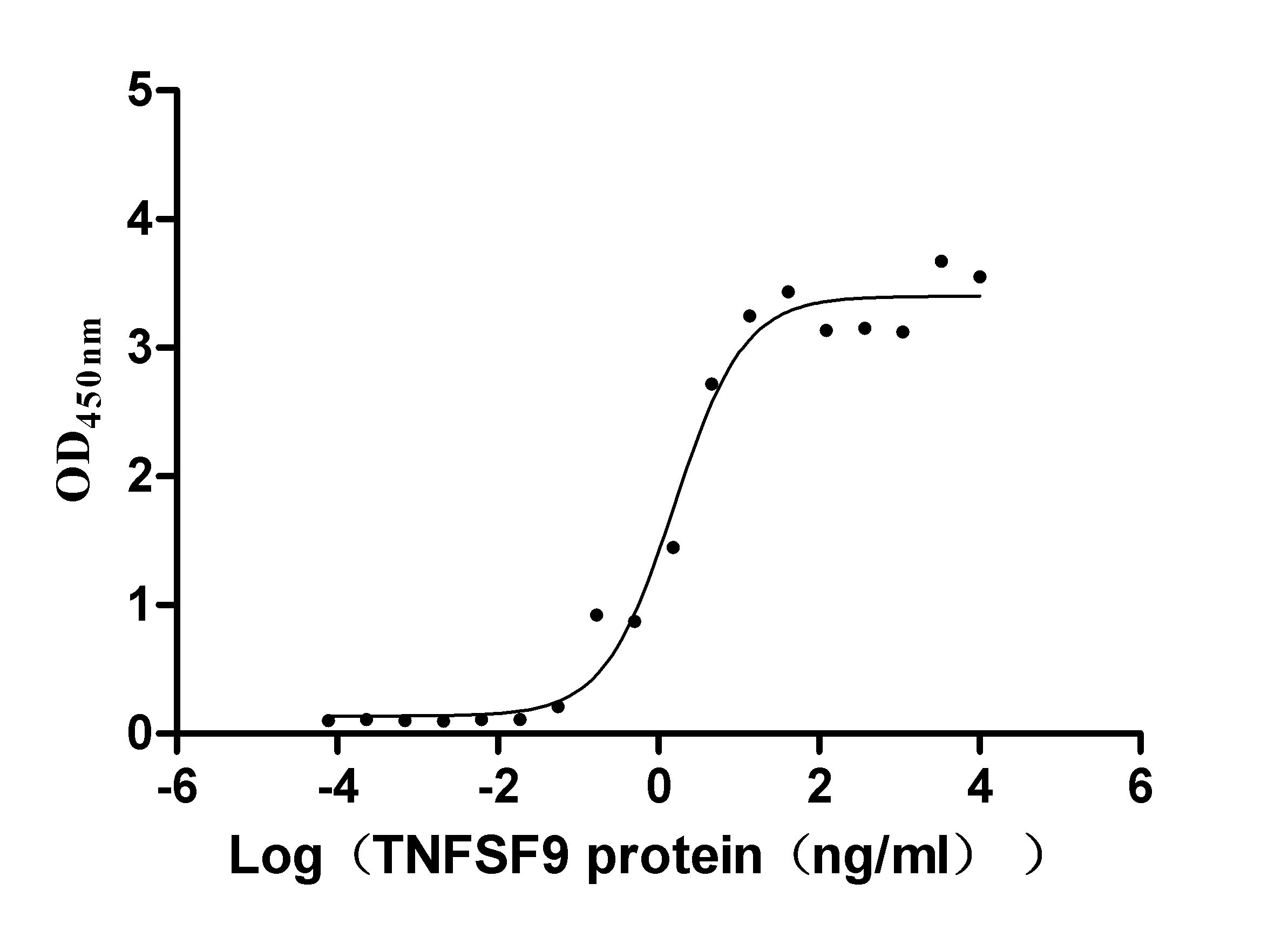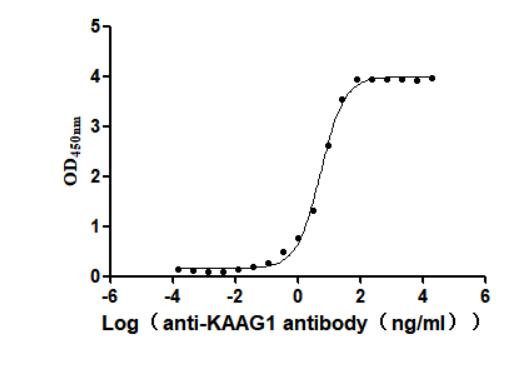Recombinant Human WD repeat domain phosphoinositide-interacting protein 1 (WIPI1)
-
货号:CSB-YP705810HU
-
规格:
-
来源:Yeast
-
其他:
-
货号:CSB-EP705810HU
-
规格:
-
来源:E.coli
-
其他:
-
货号:CSB-EP705810HU-B
-
规格:
-
来源:E.coli
-
共轭:Avi-tag Biotinylated
E. coli biotin ligase (BirA) is highly specific in covalently attaching biotin to the 15 amino acid AviTag peptide. This recombinant protein was biotinylated in vivo by AviTag-BirA technology, which method is BriA catalyzes amide linkage between the biotin and the specific lysine of the AviTag.
-
其他:
-
货号:CSB-BP705810HU
-
规格:
-
来源:Baculovirus
-
其他:
-
货号:CSB-MP705810HU
-
规格:
-
来源:Mammalian cell
-
其他:
产品详情
-
纯度:>85% (SDS-PAGE)
-
基因名:
-
Uniprot No.:
-
别名:ATG 18; ATG18; Atg18 protein homolog; ATG18A; FLJ10055; WD repeat domain phosphoinositide interacting 1; WD repeat domain phosphoinositide interacting protein 1; WD repeat domain phosphoinositide-interacting protein 1; WD40 repeat protein interacting with phosphoinositides of 49 kDa; WD40 repeat protein interacting with phosphoInositides of 49kDa; WIPI 1 alpha; WIPI 1; WIPI 49; WIPI 49 kDa; WIPI-1; wipi1; WIPI1_HUMAN; WIPI49
-
种属:Homo sapiens (Human)
-
蛋白长度:full length protein
-
表达区域:1-446
-
氨基酸序列MEAEAADAPP GGVESALSCF SFNQDCTSLA TGTKAGYKLF SLSSVEQLDQ VHGSNEIPDV YIVERLFSSS LVVVVSHTKP RQMNVYHFKK GTEICNYSYS SNILSIRLNR QRLLVCLEES IYIHNIKDMK LLKTLLDIPA NPTGLCALSI NHSNSYLAYP GSLTSGEIVL YDGNSLKTVC TIAAHEGTLA AITFNASGSK LASASEKGTV IRVFSVPDGQ KLYEFRRGMK RYVTISSLVF SMDSQFLCAS SNTETVHIFK LEQVTNSRPE EPSTWSGYMG KMFMAATNYL PTQVSDMMHQ DRAFATARLN FSGQRNICTL STIQKLPRLL VASSSGHLYM YNLDPQDGGE CVLIKTHSLL GSGTTEENKE NDLRPSLPQS YAATVARPSA SSASTVPGYS EDGGALRGEV IPEHEFATGP VCLDDENEFP PIILCRGNQK GKTKQS
-
蛋白标签:Tag type will be determined during the manufacturing process.
The tag type will be determined during production process. If you have specified tag type, please tell us and we will develop the specified tag preferentially. -
产品提供形式:Lyophilized powder
Note: We will preferentially ship the format that we have in stock, however, if you have any special requirement for the format, please remark your requirement when placing the order, we will prepare according to your demand. -
复溶:We recommend that this vial be briefly centrifuged prior to opening to bring the contents to the bottom. Please reconstitute protein in deionized sterile water to a concentration of 0.1-1.0 mg/mL.We recommend to add 5-50% of glycerol (final concentration) and aliquot for long-term storage at -20℃/-80℃. Our default final concentration of glycerol is 50%. Customers could use it as reference.
-
储存条件:Store at -20°C/-80°C upon receipt, aliquoting is necessary for mutiple use. Avoid repeated freeze-thaw cycles.
-
保质期:The shelf life is related to many factors, storage state, buffer ingredients, storage temperature and the stability of the protein itself.
Generally, the shelf life of liquid form is 6 months at -20°C/-80°C. The shelf life of lyophilized form is 12 months at -20°C/-80°C. -
货期:Delivery time may differ from different purchasing way or location, please kindly consult your local distributors for specific delivery time.Note: All of our proteins are default shipped with normal blue ice packs, if you request to ship with dry ice, please communicate with us in advance and extra fees will be charged.
-
注意事项:Repeated freezing and thawing is not recommended. Store working aliquots at 4°C for up to one week.
-
Datasheet :Please contact us to get it.
相关产品
靶点详情
-
功能:Component of the autophagy machinery that controls the major intracellular degradation process by which cytoplasmic materials are packaged into autophagosomes and delivered to lysosomes for degradation. Plays an important role in starvation- and calcium-mediated autophagy, as well as in mitophagy. Functions downstream of the ULK1 and PI3-kinases that produce phosphatidylinositol 3-phosphate (PtdIns3P) on membranes of the endoplasmic reticulum once activated. Binds phosphatidylinositol 3-phosphate (PtdIns3P), and maybe other phosphoinositides including PtdIns3,5P2 and PtdIns5P, and is recruited to phagophore assembly sites at the endoplasmic reticulum membranes. There, it assists WIPI2 in the recruitment of ATG12-ATG5-ATG16L1, a complex that directly controls the elongation of the nascent autophagosomal membrane. Together with WDR45/WIPI4, promotes ATG2 (ATG2A or ATG2B)-mediated lipid transfer by enhancing ATG2-association with phosphatidylinositol 3-monophosphate (PI3P)-containing membranes. Involved in xenophagy of Staphylococcus aureus. Invading S.aureus cells become entrapped in autophagosome-like WIPI1 positive vesicles targeted for lysosomal degradation. Plays also a distinct role in controlling the transcription of melanogenic enzymes and melanosome maturation, a process that is distinct from starvation-induced autophagy. May also regulate the trafficking of proteins involved in the mannose-6-phosphate receptor (MPR) recycling pathway.
-
基因功能参考文献:
- The specific autophagosomal localization of both WIPI1 and WIPI2 (refered to as WIPI puncta) has been employed to assess autophagy using fluorescence microscopy methods, such as confocal and live-cell video microscopy PMID: 25462558
- Data suggest WIPI1/WIPI2 co-localize with microtubule-associated light chain 3 and autophagy related proteins 2/14L, participate in biogenesis of phagosomes, autophagy, and mobilization of lipids to/from intracellular droplets. [review-like article] PMID: 25233424
- WIPI-1 and WIPI-2 are functionally required in mediating the PI3P signal at the onset of autophagy in NB4 cells. PMID: 24991767
- the detection of WIPI1 mRNA is likely to be a convenient method of monitoring autophagosome formation in a wide range of cell types PMID: 24384561
- Freeze-fracture replica immunolabelling reveals WD-repeat protein interacting with phosphoinositides 1 and 2 (WIPI-1 and WIPI-2) as membrane components of autophagosomes and the plasma membrane (PM). PMID: 21564513
- Studies define a distinct role for WIPI1 and TORC1 signaling in controlling the transcription of melanogenic enzymes and melanosome maturation, a process that is distinct from starvation-induced autophagy. PMID: 21317285
- share an evolutionary conserved function in autophagy and that autophagic capacity may be compromised in human cancers PMID: 15602573
- Quantification of WIPI-1 puncta should be suitable to assay mammalian autophagy PMID: 17618624
显示更多
收起更多
-
亚细胞定位:Golgi apparatus, trans-Golgi network. Endosome. Cytoplasmic vesicle, clathrin-coated vesicle. Preautophagosomal structure membrane; Peripheral membrane protein. Cytoplasm, cytoskeleton. Note=Trans elements of the Golgi and peripheral endosomes. Dynamically cycles through these compartments and is susceptible to conditions that modulate membrane flux. Enriched in clathrin-coated vesicles. Upon starvation-induced autophagy, accumulates at subcellular structures in the cytoplasm: enlarged vesicular and lasso-like structures, and large cup-shaped structures predominantly around the nucleus. Recruitment to autophagic membranes is controlled by MTMR14. Labile microtubules specifically recruit markers of autophagosome formation like WIPI1, whereas mature autophagosomes may bind to stable microtubules.
-
蛋白家族:WD repeat SVP1 family
-
组织特异性:Ubiquitously expressed. Highly expressed in skeletal muscle, heart, testis, pancreas and placenta. Highly expressed in G361, Sk-mel-28, Sk-mel-13, WM852 and WM451 cells. Up-regulated in a variety of tumor tissues.
-
数据库链接:
HGNC: 25471
OMIM: 609224
KEGG: hsa:55062
STRING: 9606.ENSP00000262139
UniGene: Hs.463964
Most popular with customers
-
Recombinant Human 5'-nucleotidase (NT5E) (Active)
Express system: Mammalian cell
Species: Homo sapiens (Human)
-
Recombinant Human Tumor necrosis factor receptor superfamily member 9 (TNFRSF9), partial (Active)
Express system: Mammalian cell
Species: Homo sapiens (Human)
-
Recombinant Human Angiopoietin-2 (ANGPT2) (Active)
Express system: Mammalian cell
Species: Homo sapiens (Human)
-
Recombinant Human Glucagon-like peptide 1 receptor (GLP1R), partial (Active)
Express system: Mammalian cell
Species: Homo sapiens (Human)
-
Recombinant Human C-C chemokine receptor type 8 (CCR8)-VLPs (Active)
Express system: Mammalian cell
Species: Homo sapiens (Human)
-
Recombinant Human Cadherin-1(CDH1),partial (Active)
Express system: Mammalian cell
Species: Homo sapiens (Human)
-
Recombinant Human Kidney-associated antigen 1(KAAG1) (Active)
Express system: Baculovirus
Species: Homo sapiens (Human)




-AC1.jpg)














